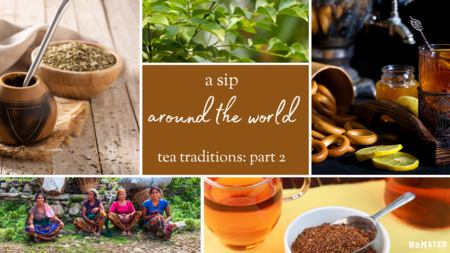5 Plants Rooted in Irish History

I always knew my grandmother's family came from Ireland but after taking a DNA test, I learned I mostly had Irish heritage. After finding this out, I began researching the history of Ireland and of course being an Herbalist, the herbs that grow in this region. Though hundreds of plants have been used medicinally in Ireland, I wanted to discuss 5 plants that are rooted in their history.
First though, I want to jump back in time and explore the culture that has used these plants. Across the Celtic region, today and in the past, plant medicine has been a primary form of health care for many people. The Celts first arrived in Ireland around 500 BC. This group of people viewed themselves as the caretakers of the land, and plants were a key player in their way of life especially within the class of the Druids. The Druids were a group of Celts that were looked upon for their knowledge in healing arts. Though the Celts mostly had a verbal language, their herbal traditions were occasionally recorded in the classic Greco-Roman texts on herbal medicines which gave us an insight as to what my ancestors used.
Despite modernization and prosecution, herbal folk remedies have always had a place in the medicine cabinets of people across Ireland. These herbal healing modalities have often been more accessible, well known, and culturally relevant to the communities of this area. In the seventeenth-century a Flemish chemist Jan Baptist van Helmont, wrote about Gaelic Ireland:
“For I remember the Chieftains of Ireland used each to give a piece of land to a healer who lived with them; not one who came back trained from the universities but one who could really make sick people well. Each such healer has a book crammed with specific remedies bequeathed to him by his forefathers. Accordingly, he who inherits the book inherits also the piece of land. The book describes the symptoms and ailments and the country remedies used for each, and the people of Ireland are cured more successfully when ill, and have generally far better health than the people of Italy.”
5 Plants Rooted in Irish History:
1. Dandelion: Taraxacum officinale
Parts Used: Whole plant

What is often considered a weed is our kindly fortifying neighbor the Dandelion plant. This commonly recognized plant is native to Europe, Asia, and Northern Africa, but is now naturalized worldwide, and its history of use goes deep into the centuries. The name was given to the plant from a 15th Century physician who noted the plant’s resemblance to the mighty lion. It is certainly much more than a standard “weed.”
In Ireland, the dandelion is linked with St Brigid (patroness saint of Ireland), giving it the name Bearnán Bríde, ‘the indented one of Brigid’, most likely because it is the first flower to bloom after St Brigid’s Festival. The Dandelion used to be cultivated in medieval monasteries such as Holy Cross in County Tipperary Ireland and featured in many meals throughout this region.
The most commonly used form of Dandelion is Common Dandelion, or Taraxacum officinale, though many other species under the Taraxacum genus possess similar properties to officinale. All parts are used, from the root to the flowerhead. It is a well-known blood cleanser and tonic, most notable for its ability to gently but efficiently flush toxins from the body without depleting it nutritionally.
Though the whole plant is used both medicinally and from a culinary perspective, two components that tend to stand out are the Root and the Leaf. Both of these plant parts hold the same affinity for the digestive and the urinary systems. They tend towards a thinning of fluids, and this allows for more secretions within these systems, thereby assisting in the removal of toxins and waste products, once again via these systems.
Dandelion Leaf is most often employed for irritation in the urinary system. It aids kidney function by upping the production of urine, thus allowing for more waste to be removed from the body. It is well-known to replace what it removes, for example, potassium excreted through the urinary system will be replaced by potassium within Dandelion. Because of this Dandelion may be very drying to some individuals. Internally and externally, the leaf can be applied to help tonify the veins and improve vascular resistance. It is topically used as a poultice for many mild skin irritations such as eczema and acne, but it may also be used this way to aid inflammation and swelling of the bones and muscles. The leaf is indicated when there is a tiredness and bodily aches that are relieved after urination.
Dandelion Root offers much of the same benefits as Dandelion Leaf, and they are often used together for their synergy. However, while the Leaf tends more towards the Urinary System, the Root finds itself offering more aid to the Digestive System. It does so by increasing the production of bile in the stomach, liver, and gallbladder, thereby allowing for better absorption of nutrients into the body. Dandelion Root contains hefty amounts of inulin which helps the body maintain a healthy gut biome. It is well suited for stagnant bile as, like the Leaf, it helps to thin secretions.
2. Comfrey: Symphytum officinale
Parts Used: Leaf and Root

Comfrey is an age-old wound-healer that has been medicinally prepared for a variety of ailments since at least 400 BCE. Well-known for its ability to quickly heal wounds, this herb has an affinity for growth, particularly cell growth of the skin, mucosal linings of the body, and the bones. It is particularly indicated for areas of the body that have experienced physical trauma and are having trouble with bodily regeneration, making it excellent at repairing severe broken bones and skin lesions.
In Irish it is known as Lus na gCnámh mBriste - the plant for broken bones. Like today, this is a common use was used historically by families in the Aran Islands, Kerry, Limerick and other parts of Ireland as a poultice for healing broken bones. In rural areas of Ireland the leaves were used for fattening pigs and as a food for cattle.
It is important to note that Comfrey is also a topic of hot debate. Many sources in our modern time discuss the prevalence of constituents within Comfrey called pyrrolizidine alkaloids. It is because of this constituent that the plant is now advised only for topical use, as it has been found to negatively affect the liver. Any internal application should be in consultation with your healthcare provider. Comfrey is recommended for skin lesions that have internally already closed. It is otherwise known to create a sort of seal on a wound. It helps to develop calluses rather quickly on the skin.
Comfrey is an extraordinarily speedy healer. It is typically made into a poultice, salve, or infused in oil to be used topically for wound-healing, bruises, bites, boils, cuts, and abscesses. Topically, it may also aid rheumatoid arthritis, bursitis, and a number of bone-related issues, as well as spinal injuries. It is a mild pain-reliever, particularly for arthritis-related complaints or in relation to the bones in general, and is known to aid inflammation in these areas as well.
3. Hawthorn: Crataegus monogyna
Parts Used: Berry, Flower, and Leaf

Hawthorn, like all members of the Rose family, finds its affinity for supporting the heart physically and emotionally. It is also, similar to many trees that provide medicine, a deeply revered plant that has been used extensively as both food and medicine for centuries. There are many ways to prepare Hawthorn, such as jams, jellies, cordials, baked into sweets, candies, and wines, to the more medicinal preparations as an herbal vinegar, tea, tinctured, or made into syrup. Hawthorn has been used throughout Europe and Asia since at least the time of Dioscorides (c. 100 BCE).
Steeped in Celtic mythology, the Hawthorn tree is said to be one of a select few gateways to the world of the Fae, alongside another well-known ancient medicine: Elder. Hawthorns are often called May trees due to their flowering coinciding with that month, and May 1st marks the Irish festival of Bealtaine, which marks the beginning of summer. In Celtic mythology Hawthorn is one of the most sacred trees and symbolizes love and protection. Also known as the fairy tree in Ireland, it was treated with great respect and was consitered bad luck to cut it down or hang on its branches.
On the medicinal side of the coin, Hawthorn is mainly employed to uplift and fortify the heart—both emotionally and physically. It assists in all manners of the heart and facilitates a number of actions such as: toning the heart muscle, improving oxygen uptake, improving circulation within the heart, dilating the peripheral blood vessels thereby reducing strain on the heart, and a general energizing of the heart and blood on a whole. Hawthorn has a normalizing effect of unhealthy cholesterol levels. Gently warming, it is subtle, and considered an adaptogen for the heart and should therefore be taken consistently and for a long period of time.
Being a member of the Rose family, Hawthorn can help the grieving heart and individuals suffering from heartbreak and debilitating sadness (especially accompanied with heart palpitations and sharp pains), and for emotional and/or physical loss of a companion, parents, or loved one. Hawthorn flower essence can assist one in accepting the inevitability of death.
4. Elder: Sambucus nigra
Parts Used: Berries, Flower, and Leaf

The Elder tree is one of a deeply ancient wisdom, and has held a stake in herbal medicine for centuries proving to be an essential asset to people the world wide. In Ireland, the elder was considered a sacred tree and, like the hawthorn tree, it was forbidden to cut one down. The elder tree was prized for its many uses both functional and spiritual.
As one can concur, many of the plants we use for herbal support hold deep histories and reverences. Elder is one such with a rich history of use, both physically and otherwise. Elder is a well-researched herb. Today, we understand that it has significant actions toward aiding many sicknesses in our bodies, particularly common colds, influenza, and conditions of the respiratory system. All parts of this tree have been used throughout its lifetime, not always medicinally. The bark and young shoots have been used to make blowpipes, broken leg splints, and musical instruments, such as the pan-flute (yet another tie to Elder is Pan’s association with the Underworld and the Forest). The leaves have been used topically for a number of skin conditions and complaints such as bruises, rashes, and wounds. Today, Elder’s primary use comes from its flowers and berries, both of which can be used interchangeably with notable differences. Elder flowers are often employed for fevers and general sicknesses. Dried, the flowers possess a cooling sedative effect on the body while also opening up all areas of the body, including the pores, allowing for excess heat to be moved outward. Fresh, the flowers are a stimulating sweat-inducer, helping to flush the system through the skin.
The berries possess very similar properties to the flowers, with notable effects as a blood toner and builder. It strengthens the circulatory system (Elder may be useful for those with Anemia). Both Elder Berry and Elder Flower possess incredible properties to assist the immune system. The berries, in particular, boost the production of what are called “cytokines.” Cytokines assist in the immune system’s response to an illness, allowing for faster reaction time, and therefore quicker healing. It is very useful in viral and bacterial conditions, especially of the respiratory system, aiding in the decongestion of the body. Elderberries are an aid for the digestive system as they possess a high amount of fiber. It is useful for allergies due to its anti-inflammatory properties, and proves an aid in Urinary Tract conditions, as it forces the kidneys to produce more urine for bodily flushing.
Two types of Elder are frequently used, and may be done so interchangeably, throughout the world: the commonly known European native Elder (Sambucus nigra) and the North American native Canadian Elder (Sambucus canadensis). Red Elder (Sambucus racemosa), which grows in the uplands of North America, should be avoided entirely.
5. Burdock: Arctium lappa
Parts Used: Root, Leaf, Seeds, Fruits

A well known herbal medicine, you may already be familiar with the Burdock plant, particularly in the Autumn when you may be having a woodland stroll, only to return home to find the forest has come with you, grabbing onto your coat in the form of tiny hook-like hairs on a little round ball. This is the Burdock plant, an herb native to Europe and Asia that is naturalized in North America and Australia. This potent yet safe herbal ally has acted as both food and medicine for centuries.
Although Burdock was the bane of most sheep herders in Ireland, it was a plant that served many uses.
The Latin taxonomy of Arctium lappa is derived from the Greek word for bear, arktos, a nod to its bear-like strength, and the Latin word lappare which means “to seize.” One can see the correlation of the species name lappa to the burs that eventually grab onto fur or clothing. This action of grabbing is how Burdock spreads its seeds in order to continue growing. When it is growing, Burdock enjoys taking up space, but always allows for the gentle nourishment of other plants. It generously offers the same energy to us.
Burdock is indicated for the individual who is generally dry and lacking in feelings of safety and security, and for those who tend towards worrying excessively, who are emotionally stoic and debilitated. This herb safely and effectively acts on any area of the body dealing with detoxification or the removal of waste products. This includes the kidneys and urinary tract, the lower digestive tract, the lymph, the liver, and the blood. It is a wonderfully grounding herb that helps the body return to a foundational state. Specifically, Burdock aids those who tend to be dryer and warmer in temperament, with dry skin, sluggish digestion, and urinary irritation, as it helps to calm and cool, providing much needed moisture to parched systems of the body.
As with any herbal treatment, we always recommend you see professional advice before using herbal medicine. And, as always, if your symptoms are persistent, please consult your physician. This is for educational purposes only.
What are your favorite Irish based remedies? Be sure to let us know in the comments below! Or even better, tag us @homsted_lifestyle to show us!!




